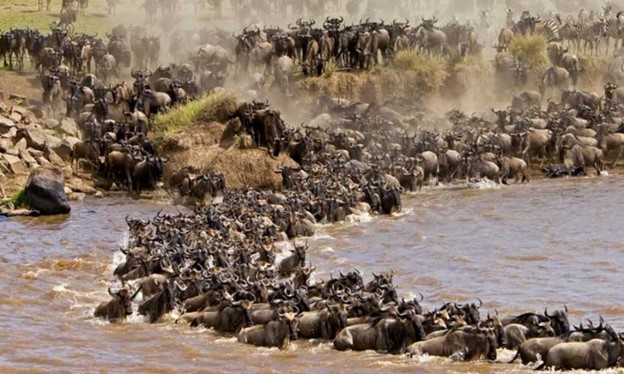Wildlife migration in Kenya is not just a spectacle it’s a rhythm, a heartbeat of nature that breathes life into the East African savannah.
With Naicef as your guide you will get to see, millions of wildebeest, zebra, antelope, and predators move in a cyclical dance of survival across Kenya’s vast and varied landscapes every year.
The significance of wildlife migration in Kenya is woven into the cultural, ecological, and economic fabric of the country.
When people hear about animal migration in Africa, the first thing that often comes to mind is the Great Wildebeest Migration and understandably so. It’s one of the most dramatic wildlife spectacles on Earth.
However, what many don’t realize is that Africa hosts several other remarkable migrations involving different species across varied landscapes.
Animal migration is not exclusive to wildebeest; birds, elephants, zebras, and even flamingos undertake long, seasonal journeys in search of food, breeding grounds, or favorable climates.
These migrations are just as impressive and vital to ecosystems and biodiversity across the continent.
For generations, local communities have lived in harmony with these great movements, their stories echoing through valleys and across plains.
Tourists, scientists, and filmmakers from all over the world flock to witness migration in Kenya, capturing scenes of drama, endurance, and raw natural beauty.
Whether it’s a stampede across the Mara River or the sudden appearance of lions stalking a herd, wildlife migration in Kenya never ceases to amaze.
With every season, every dusty trail, and every thunderous hoofbeat, wildlife migration in Kenya writes another chapter in one of the planet’s most awe-inspiring sagas.
What are you waiting for contact my@naicef.com or call +254799922277 for the best tours across all destinations in Kenya!
Book The Tour Here
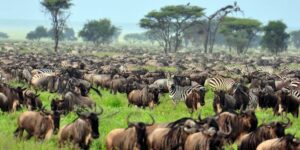
Wildlife Migration in Kenya
Kenya is one of the best places in the world to witness incredible wildlife migrations.
Every year, millions of animals move across vast landscapes in search of food, water, and safe places to breed.
These migrations are not only breathtaking to see, but they also play a crucial role in keeping nature balanced.
Here are some of the most remarkable migrations you can witness in and around Kenya
1. Wildebeest Migration
The wildebeest migration is Africa’s most famous wildlife event.
Over 1.5 million wildebeest, along with zebras and gazelles, travel in a circular route through the Serengeti in Tanzania and into the Maasai Mara in Kenya.
This journey covers about 1,800 miles each year.
They move in search of greener grass and water, facing dangerous river crossings filled with crocodiles and predators like lions and hyenas.
It’s an awe-inspiring sight and a vital part of life in the savannah, supporting many other animals that rely on the herd for food
2. Elephant Migration
Elephant migrations may not be as dramatic as the wildebeest, but they are just as important.
African elephants travel long distances in search of water and fresh vegetation, especially during dry seasons.
In Kenya, elephants follow ancient paths between places like Chyulu Hills, Tsavo, and Amboseli.
These routes have been used for generations and are crucial for survival.
As they move, elephants also shape the land by clearing paths, opening up vegetation, and even creating new water holes helping other animals and plants thrive.
3. Bird Migration
Millions of birds fly to and through Africa every year, making it a paradise for birdwatchers.
Some birds travel from as far as Europe and Asia to escape the cold winters and breed in warmer climates.
In Kenya, you can see birds like the European bee-eater, white stork, and lesser kestrel on their long journeys.
Locally, flamingos also move between lakes like Nakuru and Bogoria, following the rise and fall of water levels and food availability.
The number and variety of birds involved make this one of the most impressive natural events on the continent.
4. Zebra Migration
While zebra migrations in Botswana are more widely known, Kenya also sees important seasonal movements of zebras, especially in areas like the Maasai Mara and Laikipia.
These zebras, often seen alongside wildebeest during the Great Migration, move in search of fresh grazing land and water as the seasons change.
In the Maasai Mara, thousands of Burchell’s zebras migrate along with wildebeest, traveling between Kenya and Tanzania.
Their journey follows the rains, and they play a key role in keeping the grasslands healthy by grazing on tougher grasses before the wildebeest arrive.
In places like Laikipia and the northern rangelands, zebras particularly the endangered Grevy’s zebra move within wider landscapes to access resources.
These migrations are smaller and less dramatic but just as vital for their survival, especially during dry spells.
Whether in massive herds or smaller groups, zebra migrations in Kenya are a powerful example of how animals adapt to changing environments and help maintain the balance of their ecosystems.
5. Flamingo Migration
The flamingo migration is a magical sight, especially in Kenya’s Rift Valley.
Thousands of lesser flamingos move between alkaline lakes like Lake Natron, Lake Bogoria, and Lake Nakuru.
These birds feed on special algae that grow in the salty, soda-rich waters.
Their migration is influenced by changes in water chemistry, food supply, and breeding needs.
When the flamingos gather in massive pink flocks, the scene is almost dreamlike drawing photographers and bird lovers from around the glob
Wildlife Migration Routes
As these animals’ journey across the land, they follow ancient wildlife migration routes paths carved into the earth not by humans, but by instinct, memory, and necessity.
These wildlife migration routes stretch across national borders, crossing rivers, plains, and even human settlements.
Protecting these migration routes has become a priority for conservation groups, as development, agriculture, and climate change threaten to disrupt their continuity.
The beauty of migration routes lies in their unpredictability; while some herds stick to traditional paths, others veer off course in search of food and water.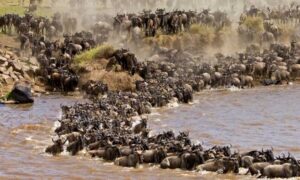 Throughout history, wildlife migration routes have inspired myths, guided nomadic tribes, and ensured biodiversity thrives in East Africa.
Throughout history, wildlife migration routes have inspired myths, guided nomadic tribes, and ensured biodiversity thrives in East Africa.
In today’s world, with GPS tracking and aerial drones, we can now follow these migration routes in incredible detail yet the mystery and magic of the journey remain.
Wildlife Migration Routes In Kenya
In Kenya, these ancient tracks take shape as distinct wildlife migration routes in Kenya, offering a blueprint for understanding the movement of life across the country’s diverse ecosystems.
Whether it’s the renowned Mara-Serengeti loop or the lesser-known Laikipia passage, wildlife migration routes in Kenya serve as highways of life, connecting herds to vital grazing lands and water sources.
Across the regions of Narok, Kajiado, Samburu, and more, these migration routes in Kenya are both ecological corridors and cultural landmarks.
In some places, villagers tell tales of how the ancestors predicted the herds’ return each year with uncanny accuracy, speaking of migration routes in Kenya as if they were living entities.
But as Kenya grows, these migration routes in Kenya face increasing pressures.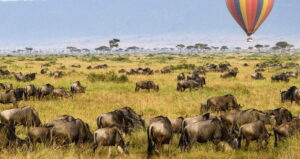 Roads, farms, and fences now intersect many of these pathways, forcing a reevaluation of how development and nature can coexist.
Roads, farms, and fences now intersect many of these pathways, forcing a reevaluation of how development and nature can coexist.
For conservationists, maintaining the integrity of migration routes in Kenya is a race against time.
May Wildlife Migration
The story begins each year with the May wildlife migration, a powerful kickoff to the great northward movement.
As the long rains fall in Tanzania’s Serengeti, grass begins to flourish, triggering the start of May migration.
Wildebeest, driven by hunger and ancient instinct, begin their journey toward the greener pastures of the Maasai Mara.
This phase of May wildlife migration is both crucial and perilous.
Newborn calves some just days old must keep pace with the herds or risk falling prey to predators.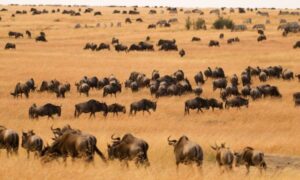 During May wildlife migration, crocodiles lie in wait at river crossings, and lions trail the herds, capitalizing on the chaos.
During May wildlife migration, crocodiles lie in wait at river crossings, and lions trail the herds, capitalizing on the chaos.
Local guides often recount how they watched in awe as a mother wildebeest fended off a lion during a desperate dash across the Talek River an unforgettable moment in May migration.
As the skies clear and the grass shortens, May migration gives way to the full grandeur of the Kenyan migration season.
May Wildlife Migration Corridors
Yet these great movements would not be possible without the often invisible but vitally important May wildlife migration corridors.
These corridors are the arteries that keep the migration alive, enabling wildlife to move safely between reserves, conservancies, and communal lands.
In Kenya, May wildlife migration corridors are increasingly recognized for their ecological importance.
As the country urbanizes, the survival of species hinges on these fragile pathways.
During the May wildlife migration corridors, elephants, zebras, and antelopes pass-through privately-owned lands, often clashing with human activities.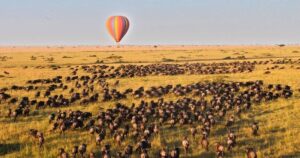 However, many landowners have come together to protect these wildlife migration corridors, forming conservancies and engaging in eco-tourism initiatives.
However, many landowners have come together to protect these wildlife migration corridors, forming conservancies and engaging in eco-tourism initiatives.
In the Amboseli region, for example, communities have secured vital wildlife migration corridors by fencing off farmland and working with NGOs to install wildlife-friendly infrastructure.
It’s a delicate balance honoring the needs of people and the rights of animals during May wildlife migration corridors that support millions.
Top 5 Wildlife Migration Routes In Kenya
Below are the five ultimate migration routes in Kenya:
1. Mara–Serengeti Route (The Great Migration Loop)
This is by far the most iconic and heavily documented wildlife migration route in Kenya.
Spanning from Tanzania’s Serengeti into Kenya’s Maasai Mara, this corridor is a hotbed of drama, survival, and spectacle.
Every May wildlife migration, millions of wildebeest cross into Kenya, navigating the treacherous Mara River a scene where crocodiles ambush and predators wait in ambush.
Veteran guides recall stories of wildebeest stampedes so massive that the dust cloud could be seen from miles away.
For many, witnessing the Mara crossing during May migration is a once-in-a-lifetime experience.
Below are some of Naicef packages that you would not want to miss when it comes to wildlife facts:
- Best time to visit safaris in Kenya / Wildlife, Luxury Family 2025 Guide
- Discover the best luxury safaris in Kenya
- The best safari tours in Kenya and best safari packages in Kenya
2. Loita Plains to Mara Triangle Corridor
This lesser-known route is critical for dispersing pressure from the main migration.
During May wildlife migration, smaller herds enter the Mara from the Loita Hills region.
These May wildlife migration corridors are essential for wildlife escaping overcrowding or seeking new grazing spots.
An elder from the local Loita Maasai community recalls the days when elephants would thunder past their boma (homestead), announcing the arrival of the herds and predators alike.
3. Laikipia to Samburu Migration Pathway
Used especially by elephants and antelope, this northern corridor ensures genetic diversity among populations.
The migration routes in Kenya that span Laikipia are increasingly fragmented due to private ranches and development.
Yet conservationists have formed landowner alliances to protect movement during May migration and beyond.
A Laikipia ranger once described an incident where an elephant cow led her family through a freshly ploughed field, carefully avoiding damage proof of memory and wisdom passed down through generations.
4. Amboseli to Tsavo Corridor
Elephants and smaller herbivores migrate between these southern parks, using corridors that pass through populated areas.
Here, the importance of May wildlife migration corridors cannot be overstated.
Human-wildlife conflict is frequent, but stories of peaceful coexistence abound too.
A herder from the Chyulu Hills remembers a time when his goats grazed peacefully alongside zebra during the May wildlife migration, under the watchful eye of a distant lion.
5. Athi-Kapiti Plains Migration Route
Close to Nairobi county, this route used to be a stronghold of the migration, but urban sprawl has greatly reduced its capacity.
Still, during May migration, some animals persist, following remnants of ancient paths.
Conservationists are working to restore this route by negotiating with landowners to create green corridors hope remains that this once vibrant migration routes in Kenya can thrive again.
So are you looking forward to come and see these migrations happening in Kenya and Africa at large? Of course you got the urge, you need to understand every tour should be planned before.
Below are some of Naicef packages to assist you in your planning to a safari to Kenya and Africa:
- Top 4 best ways on how to plan a family safari in Africa
- 10 best tips on what to pack for a safari In Kenya
Conclusion
The wonder of migration in Kenya is not just about animals on the move it’s about the heartbeat of a country that still retains its deep connection with the wild.
These ancient movements, along migration routes, through May migration corridors, define Kenya’s identity as a conservation powerhouse.
Every river crossed, every predator evaded, and every calf born along the way is a story of survival that stretches back millennia.
As climate change, fencing, and urbanization threaten these routes, the fight to preserve wildlife migration in Kenya becomes more urgent.
This isn’t just about preserving tourism or biodiversity it’s about protecting the very soul of Kenya’s wild lands.
With continued conservation, community cooperation, and innovation, wildlife migration in Kenya will not only survive, but continue to inspire awe for generations to come.
What are you waiting for contact my@naicef.com or call +254799922277 for the best tours across all destinations in Kenya!
Book The Tour Here
Frequently Asked Questions (FAQs)
1. When is the best time to see the wildlife migration in Kenya?
The most dramatic moments of wildlife migration in Kenya occur between July and September, but it begins in May. The migration is when herds start moving north into Kenya via crucial wildlife migration routes in Kenya.
2. What animals are involved in Kenya’s migration?
Primarily wildebeest, but also zebra, gazelle, topi, eland, and predators like lions and hyenas. Elephants and buffalo also use May migration corridors in different regions.
3. Why is May important in the migration cycle?
May wildlife migration marks the beginning of movement from Tanzania to Kenya, often following rainfall and fresh grazing. It’s a critical time when May migration corridors must remain open and safe.
4. Are migration routes in Kenya endangered?
Yes, many wildlife migrations routes in Kenya face threats from development, fencing, and agriculture. Conservation efforts aim to keep May migration corridors intact.
5. How can visitors support wildlife migration conservation?
Travel with eco-friendly tour operators, support community conservancies, and contribute to NGOs working to preserve wildlife migration routes in Kenya and protect the May migration.
